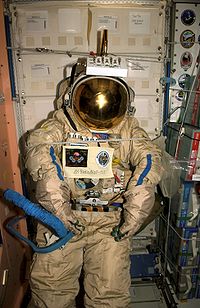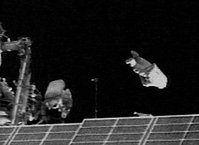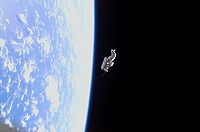- SuitSat
-
SuitSat (also known as Mr. Smith, Ivan Ivanovich, RadioSkaf, Radio Sputnik[citation needed] and AMSAT-OSCAR 54) is a retired Russian Orlan spacesuit with a radio transmitter mounted on its helmet. SuitSat-1 was deployed in an ephemeral orbit around the Earth on February 3, 2006. The idea for this novel OSCAR satellite was first formally discussed at an AMSAT symposium in October 2004, although the ARISS-Russia team is credited with coming up with the idea as a commemorative gesture for the 175th anniversary of the Moscow State Technical University.
"SuitSat is a Russian brainstorm," according to Frank Bauer of NASA's Goddard Space Flight Center. "Some of our Russian partners in the ISS program, mainly a group led by Sergey Samburov, had an idea: Maybe we can turn old spacesuits into useful satellites." SuitSat is a first test of that idea.[1]
Contents
SuitSat-1
In a move originally planned for December 6, 2005, SuitSat-1 entered its own independent orbit just after 23:05 UTC on February 3, 2006 when it was taken on a spacewalk from the International Space Station by Valery Tokarev and Bill McArthur as part of an unrelated spacewalk. Voice messages recorded by the teams involved, and by students from around the globe, were continuously broadcast in a number of languages from the SuitSat, along with telemetry data. The signal began transmission approximately 15 minutes after SuitSat-1 was jettisoned and was relayed by equipment onboard the ISS. Anyone receiving the transmission could log an entry on the tracker at suitsat.org, detailing when and where they heard it.
However, the SuitSat-1 mission was not a total success. There were very few reports that actually confirmed the receiving of the transmission. NASA TV later announced that SuitSat ceased functioning after only two orbits due to battery failure, but there were reports suggesting that SuitSat-1 continued transmitting, though far weaker than expected.
The official designation for SuitSat is AMSAT-OSCAR 54, though it was nicknamed "Ivan Ivanovich" or "Mr. Smith". The radio transmitter used a frequency of 145.990 MHz.
The last confirmed signal report from SuitSat-1 was the report of KC7GZC on February 18, 2006, all later reports indicate that no signal was received when SuitSat-1 was due to pass over.
On September 7, 2006, at 16:00 GMT, Suitsat re-entered the Earth's atmosphere over the Southern Ocean at 110.4° East latitude and 46.3°South longitude. It was over a point some 1400 km south-southwest of Cape Leeuwin (Augusta), Western Australia.[2]
ARISSat-1 (formerly SuitSat-2)
Main article: KedrARISSat-1, another ISS hand launched satellite, is currently in development. This satellite will contain experiments built by students and a software defined radio capable of supporting a U/v linear transponder, FM telemetry, voice recordings and live SSTV imagery. Unlike SuitSat-1, the batteries on ARISSat-1 will be charged by solar panels, and is predicted to have a lifetime up to six months (when it is expected to deorbit).
References
External links
- AMSAT satellite detail
- suitsat.org
- Russian site about SuitSat satellite series
- SuitSat Audio Recordings and Updates - AJ3U.com
- NASA press release: "SuitSat: Using a simple police scanner or ham radio, you can listen to a disembodied spacesuit circling Earth."
- NASA Releases SuitSat 1 includes video and technical details
- "SuitSat-2 Now Called ARISSat-1"
Space suits USSR / Russia 
United States Navy Mark IV · Gemini · MOL · Apollo/Skylab A7L · Shuttle Ejection Escape Suit · Launch Entry Suit (LES) · Advanced Crew Escape Suit (ACES) · Extravehicular Mobility Unit (EMU) · Constellation Space SuitChina Developmental Components Related topics ← 2004 · Orbital launches in 2005 · 2006 → Deep Impact | Kosmos 2414 · Universitetsky-Tatyana | AMC-12 | USA-181 | XTAR-EUR · Maqsat-B2 (Sloshsat-FLEVO) | Himawari 6 | Progress M-52 (TNS-0) | XM-3 | Inmarsat-4 F1 | Ekspress AM-2 | USA-165 | Apstar VI | Soyuz TMA-6 | DART | Spaceway 1 | USA-182 | Cartosat-1 · HAMSAT | NOAA-18 | DirecTV-8 | Foton-M2 | Progress M-53 | Molniya-3K #12 | Cosmos 1 | Intelsat Americas 8 | Ekspress AM-3 | Shijian 7 | Suzaku | STS-114 (Raffaello MPLM) | FSW-21 | Thaicom-4 | MRO | Kirari · Reimei | Monitor-E | FSW-22 | Kosmos 2415 | Progress M-54 (RadioSkaf) | Anik F1R | USA-183 | Soyuz TMA-7 | CryoSat | Shenzhou 6 | Syracuse 3A · Galaxy 15 | USA-186 | Beijing-1 · TopSat · Sina-1 · SSETI Express (CubeSat XI-V · UWE-1 · nCUBE-2) · Mozhaets-5 · Rubin-5 | Inmarsat-4 F2 | Venus Express | Spaceway-2 · Telkom-2 | Gonets-D1M #13 · Kosmos 2416 | Meteosat 9 · INSAT-4A | Kosmos 2417 · Kosmos 2418 · Kosmos 2419 | GIOVE-A | AMC-23Payloads are separated by bullets ( · ), launches by pipes ( | ). Manned flights are indicated in bold text. Uncatalogued launch failures are listed in italics. Payloads deployed from other spacecraft are denoted in brackets. Categories:- Amateur radio satellites
- 2005 in spaceflight
- 2006 in spaceflight
Wikimedia Foundation. 2010.



